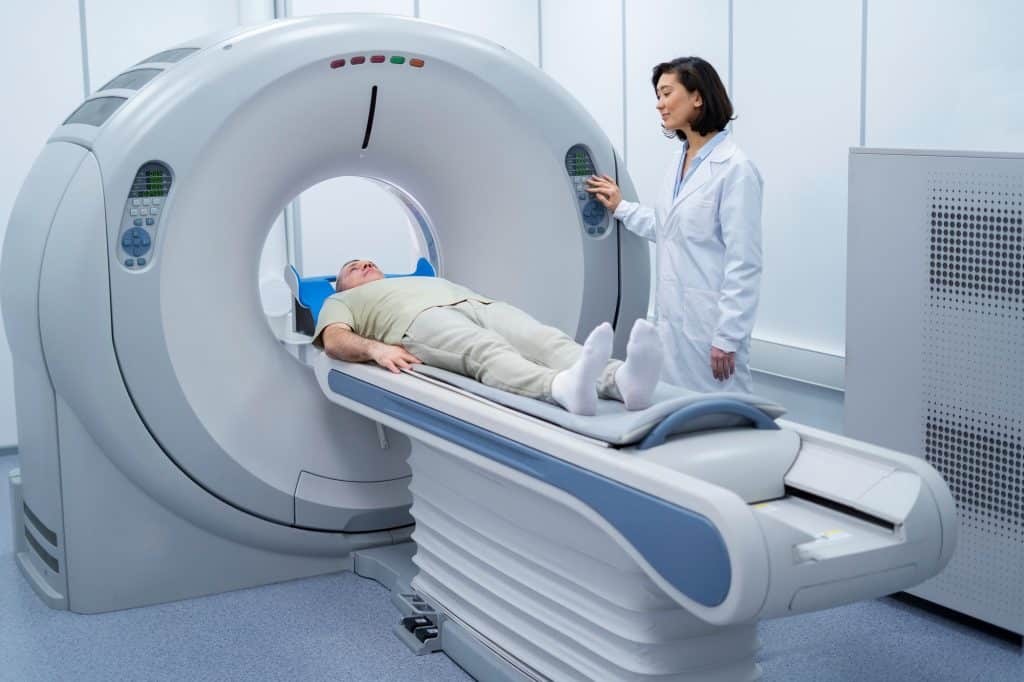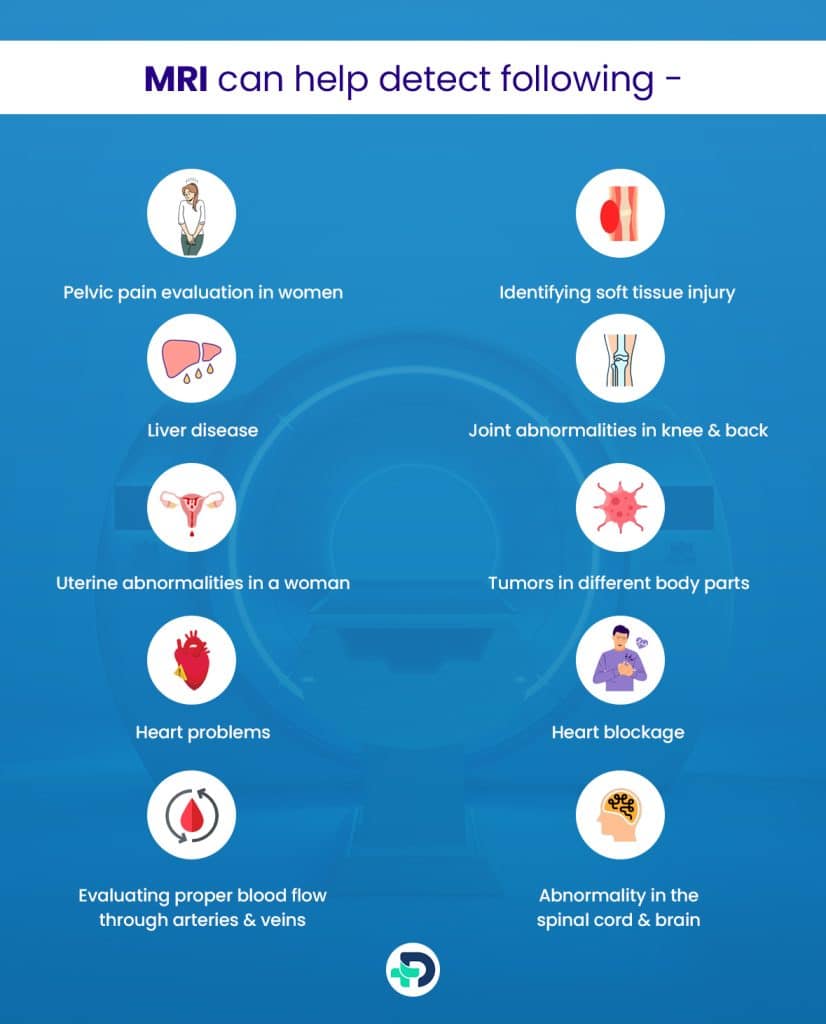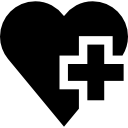Understanding the Imaging process called MRI

- MRI
- 22 Aug 2023
Overview
What is MRI?
Magnetic resonance imaging (MRI) is a non-surgical procedure that uses radio waves, magnets, and computer applications to get detailed three-dimensional images of the body’s interior structures, such as muscles, soft tissues, and organs.
Like other popular techniques viz; X-ray and CT scan, MRI technique does not utilize radiations;4Overview| Researched based study from Nlm.nih.gov hence it is a safe procedure for people needing frequent scans for persistent illness. Doctors use MRI to identify and for treatment assessment of several health conditions such as tumors, heart issues, etc 1Overview| Researched based study from Sciencedirect.com
The article will briefly glimpse the MRI scan, its working, procedure, uses, and risks.

Here are some quick facts about MRI
- MRI is a painless, non-invasive technique
- MRI technique is different from that of X-rays and CT-scans
- Raymond Damadian designed the first whole-body MRI and named it Indomitable
- In 2003, Lauterbur and Mansfield received the Nobel Prize for their discoveries regarding MRI 2Overview| Researched based study from Nlm.nih.gov
Types
Types of MRI
Types of MRI are as follow:
- Open MRI
- Closes MRI
Open MRI
- There are two magnets in the open MRI machine, one is on the top of the body, and the other is beneath.3Types| Researched based study from Sciencedirect.com
- The MRI machine’s boundaries are open, which makes it a good option for people with claustrophobia (fear within closed spaces). It produces superior-quality images of the body’s internal structures.
Closed MRI
- It is the traditional MRI machine whose edges are closed. For a closed MRI, the doctor allows the individual to lie in a tube-shaped channel, where the magnetic ring surrounds the entire body. It produces detailed images of the body’s internal structures 3Types| Researched based study from Sciencedirect.com
Uses

Uses of MRI
Doctors use MRI to identify a variety of medical illness. Some of the health issues that MRI can detect are as follows:
- Tumors in different body parts
- Abnormality in the spinal cord and brain
- Joint abnormalities in knee and back
- Heart problems
- Liver disease
- Uterine abnormalities in a woman
- Pelvic pain evaluation in women
- Heart blockage
- Identifying soft tissue injury
- Evaluating proper blood flow through arteries and veins 5Uses| Researched based study from Nlm.nih.gov
The Process
MRI procedure
The doctor performs the MRI procedure in the following ways:
- The individual will initially change and wear a paper gown and take away any metallic things viz; necklace, rings, and watches. They might provide ear-protective devices to tolerate the MRI machine noises
- The doctor will then ask him to lie on the scanning table, and then gradually, he will be moved into the MRI machine. The medical staff will be able to talk with him during the procedure while inside the MRI machine
- Once started, the machine will make certain loud beeping sounds of up to 120 decibels
- During the scan, he might need to remain motionless. The person might feel warm in the scanned body areas
- The scan might continue for twenty to ninety minutes, depending on the body’s location 6The Process| Researched based study from Nlm.nih.gov
MRI Preparation
There is very little preparation before starting an MRI.
- For pelvic or abdominal MRI, the doctor might forbid the individual to take any food or drink for about five to six hours before the scan.
- However, for the scan of other body areas, the person might continue eating, drinking, and taking medications as usual.
- For MRI scans for children, the doctor might give sedatives (drugs to induce sleep) or anesthesia before the procedure. He might also mention specific instructions on eating and drinking in consideration of anesthesia 7The Process| Researched based study from Nlm.nih.gov
During MRI scan
- Once the physician puts the patient in the tube-like channel of the MRI machine, the medical staff can speak to the individual through an intercom to ensure that he is comfortable. However, the doctor will not run the MRI if there is any anxiety or discomfort with the patient.
- The patient must stay motionless during the process, as any movement will ruin the images.
- The person will hear loud sounds during the entire procedure. Sometimes the doctor might ask the patient for momentary breath-holding depending on the type of pictures taken.
However, one feeling uncomfortable during the scanning procedure might talk to the medical staff through the intercom and request the immediate stopping of the system 7The Process| Researched based study from Nlm.nih.gov
Post MRI scan
- After the MRI scan, the patient might need to stay until the doctor ensures that all images are perfect.
- If the images are not good, the patient might require entering the MRI machine and retake those images.
- After everything seems good, the patient can change clothes and return home.
- However, patients given sedatives before the MRI scan must wait until he recovers from the effect before going home.
MRI interpretation
- The Radiologist or doctors specialized in reading medical imaging techniques will interpret the MRI results and write in detail the radiology report about the results of the findings.
- The patient might then require an appointment with the concerned doctor for further result evaluation and the subsequent treatment steps.
MRI using contrast
- The physician might sometimes direct for MRI using contrast. Before the procedure, the doctor will inject a contrast agent viz; gadolinium metal into the patient’s vein.
- The metal helps in giving a sharper, clear image of the body’s internal structures12The Process| Researched based study from Nlm.nih.gov
Side effects
Side effects of MRI
People on contrast material for MRI might have the following side effects:
- Pain in the injection site
- Headache
- Nausea and vomiting
- Allergic reactions such as itching, hives (in rare cases)8Side effects| Researched based study from Nlm.nih.gov
Other risks
- People with malfunctioning kidneys who undergo MRI with contrast material might suffer from a fatal disease called nephrogenic systemic fibrosis (a condition that causes the thickening of the tissues and organs)8Side effects| Researched based study from Nlm.nih.gov
- The MRI machine uses strong magnets to take the internal image of the body. Hence the presence of any metal objects in the body can be a health hazard for the individual due to attraction by the magnet.
- To avoid potential risk, one must inform the doctor or the technician regarding any metallic devices in the body.
- Some examples of the list of metallic devices are Pacemaker, Metallic joints, Metallic plates, screws, or stents, Implants, IUD’s etc. 9Side effects| Researched based study from Nlm.nih.gov
Contraindications
Contraindications
MRI is usually safe for most people.
However, MRI might not be appropriate for some people with the following health conditions viz;
- Ones with a fear of enclosed spaces
- Pregnant women in the first three months
- Nursing mothers
- People with liver problem
- People with kidney malfunctioning and needing dialysis 10Contraindications| Researched based study from Nlm.nih.gov
Vs. CT Scan
MRI Vs CT Scan
- MRI uses radio waves, magnets, and computers to get a thorough picture of the body’s interiors. In contrast, CT (Computed tomography) scan uses X-ray (ionizing radiation) and computers to get a picture of the body’s internal structures.
- Doctors often suggest MRI than X-ray as MRI is a safer technique without harmful radiation. Also, MRI provides a clearer picture of the internal organs than CT scans.
- However, MRI is unsuitable for people with pacemakers or insulin pumps (devices to deliver insulin into the body). In that case, the doctors often recommend a CT scan as the second option to get a good image.
- MRI is an expensive technique compared to a CT scan 11Vs. CT scan| Researched based study from Nlm.nih.gov
Takeaway
Key Takeaways
- MRI is a valuable instrument for getting detailed pictures of muscles, soft tissues, tumors, and other medical conditions
- MRI is a safe imaging procedure for people who require multiple scans in the treatment process
- Open MRI is another alternative for people considering closed spaces and loud noise.
Any feedback on this article?
 This Articles content was accurate
This Articles content was accurate Very Informative Article
Very Informative Article I have a question or a comment
I have a question or a comment
 This article contains inaccurate content
This article contains inaccurate content This article was not helpful
This article was not helpful I have a question or a comment
I have a question or a comment
We appreciate your helpful feedback!
Checkout our social pages
References
-
Science Direct
Magnetic Resonance Imaging - an overview | Overview
-
National Library of Medicine
The Nobel Prize in Physiology or Medicine in 2003 to Paul C. Lauterbur, Peter Mansfield for magnetic resonance imaging | Overview
-
Science Direct
3D gradient coil design for open MRI systems | Types
-
National Library of Medicine
Magnetic resonance imaging | Overview
-
National Library of Medicine
The role of MRI in musculoskeletal practice: a clinical perspective | Uses
-
National Library of Medicine
Magnetic Resonance Imaging: Principles and Techniques: Lessons for Clinicians | The Process
-
National Library of Medicine
MRI safety: a report of current practice and advancements in patient preparation and screening | The Process
-
National Library of Medicine
Biological Effects and Safety in Magnetic Resonance Imaging: A Review | Side effects
-
National Library of Medicine
Assessing the Risks Associated with MRI in Patients with a Pacemaker or Defibrillator | Side effects
-
National Library of Medicine
Risk of Nephrogenic Systemic Fibrosis in Patients With Stage 4 or 5 Chronic Kidney Disease Receiving a Group II Gadolinium-Based Contrast Agent: A Systematic Review and Meta-analysis | Contraindications
-
National Library of Medicine
CT Scan | Vs. CT Scan
-
National Library of Medicine
Gadolinium as an MRI contrast agent | The Process





































